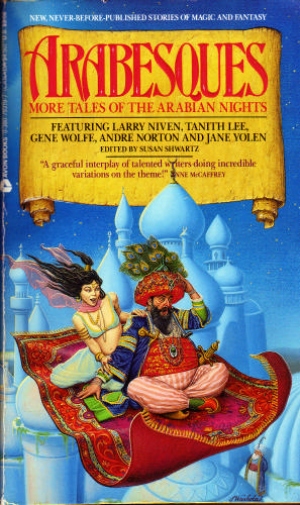Birthday Reviews: William R. Forstchen’s “The Truthsayer”

William R. Forstchen was born on October 11, 1950.
Forstchen is a professor of American History, specializing in military history, the Civil War, and the history of technology. He may be best known in science fiction circles for his The Lost Regiment series and for a series of alternate history novels co-written with Newt Gingrich. Forstchen has also collaborated on fiction with Larry Segriff, Raymond E. Feist, Jaki Demarest, Greg Morrison, Andrew Keith, Ben Ohlander, Christopher Stasheff, and John Mina. He has collaborated with Bill Fawcett, Jennie Ethell Chancey, and Donald V. Bennett on non-fiction.
“Truthsayer” originally appeared in Susan Shwartz’s anthology Arabesques: More Tales of the Arabian Nights, in 1988. In 2007, it was translated into French as “Le diseur de vérité” for publication in the anthology Fantasy 2007, published by Bragelonne.
Forstchen retells the story of the fall of the empire of Khwarazm and the flight of Muhammad Shah from his empire in “Truthsayer.” Historically, Ala ad-Din Muhammad incurred the wrath of Chinggis Khan by murdering a Mongol ambassador who sought to establish trade between the Mongol and Khwarezmian empires. Chinggis led armies into Khwarezm to exact vengeance and the Mongol armies, led by the Mongol general Subutai, destroyed the empire, murdering millions while Muhammad fled, eventually to die of disease on an island in the Caspian Sea.
In Forstchen’s version, Muhammad is accompanied by Ali, a Truthsayer. In this world, Truthsayers, of whom Ali is the last of a long line, have the ability to tell if someone is telling the truth, and the inability to lie. At the same time, they have a magic to evoke the truth from people. Muhammad makes rare use of Ali’s ability, but includes him on his flight from the Mongols. In the end, Muhammad abandons his entourage and Ali learns from the Khwarazm general Maluk that Muhammad feared and hated Ali for the truth the man had forced the shah to confront.
Ali reveals more of his origins when he is taken before Subutai, anticipating his own death as the Mongol general seeks to learn the location and plans of the fled shah. While Subutai has plotted ways to force the truth from a recalcitrant Truthsayer, Ali faces his own challenge when he must decide whether to tell the truth or break a vow that he made to Muhammad, both of which are anathema to him.
The destruction of Khwarazm and the depredations of the Mongols are a constant in the story, although they are also background. The horror that was visited on the empire is shown with an almost clinical or historical detachment, mostly taking place off stage. There is little sense of Mongol motivation for their continued attacks and they don’t even appear as a force of nature, which they surely appeared to those who were caught in their path.
Reviewed in its original appearance in the anthology Arabesques: More Tales of the Arabian Nights, edited by Susan Shwartz, Avon Books, 1988.
 Steven H Silver is a sixteen-time Hugo Award nominee and was the publisher of the Hugo-nominated fanzine Argentus as well as the editor and publisher of ISFiC Press for 8 years. He has also edited books for DAW and NESFA Press. He began publishing short fiction in 2008 and his most recently published story is “Webinar: Web Sites” in The Tangled Web. Steven has chaired the first Midwest Construction, Windycon three times, and the SFWA Nebula Conference 6 times, as well as serving as the Event Coordinator for SFWA. He was programming chair for Chicon 2000 and Vice Chair of Chicon 7. He has been the news editor for SF Site since 2002.
Steven H Silver is a sixteen-time Hugo Award nominee and was the publisher of the Hugo-nominated fanzine Argentus as well as the editor and publisher of ISFiC Press for 8 years. He has also edited books for DAW and NESFA Press. He began publishing short fiction in 2008 and his most recently published story is “Webinar: Web Sites” in The Tangled Web. Steven has chaired the first Midwest Construction, Windycon three times, and the SFWA Nebula Conference 6 times, as well as serving as the Event Coordinator for SFWA. He was programming chair for Chicon 2000 and Vice Chair of Chicon 7. He has been the news editor for SF Site since 2002.